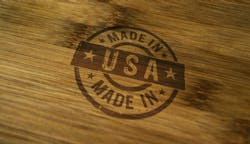Rethinking the Global Supply Chain
Talk with your suppliers and they’ll tell you most of the materials and products they stock and sell either come from China or are manufactured with one or more components made in China. Very few building products are made completely in the United States.
Day to day, that reality can sometimes be problematic, but in a crisis such as a global pandemic, it’s a serious problem. Remember in the early months of COVID-19 how hard it was to get personal protective equipment, namely face masks, hand sanitizer, and gloves? Similarly, we often think some building materials are more critical than others, but any material is critical when you can’t get it.
So perhaps we do need to rethink our approach to building products and where they are made. The benefits of a stronger domestic manufacturing base include shorter lead times, greater design agility and resource efficiency, and better risk mitigation. Buying U.S.-made products also creates jobs, which benefits homebuyers working to afford the homes we build.
RELATED
- Home Builders, How’s Your Supply Chain?
- Supply Chain Relationships: What's Working and What's Not [Research]
- Supplier Survival: Adopt a Highly Differentiating Approach
Lead Time for Building Materials
My first job during my senior year in high school and all through college was in a manufacturing plant, where we made products of steel, wire, and wood. The company also sourced injection-molded, vacuum-formed, and rotational-molded plastic components from other local manufacturers. It had a paint line, screen printing, sewing, and tool-and-die capabilities as well, using a wide range of materials to make everything from store displays to truck parts. And the company drop-shipped to your location.
To reap the same benefits now, look for U.S. companies that manufacture roof tile, engineered wood products, windows, doors, stone, brick, and other products. They likely can help you when you’re in a pinch and require products manufactured quickly. Need something from China quickly? If you can get it at all in this crisis, it will require air freight, and those 6,000 miles won’t be cheap in dollars or the resulting burden on the environment.
Design Agility and Local Manufacturing
It’s much easier to design products for your homes when you’re working with a local manufacturer. You can sit around a table together and use techniques, such as concurrent engineering, to design new products or tweak existing ones. Local manufacturers often respond quickly with prototypes, and they typically have the ability to tweak them to meet your schedule.
Think about work you may have done with, say, a local metal shop for ornamental iron, or with a local truss manufacturer. You can make changes in days, instead of the months required when using an offshore supplier.
Think of the work you may have done with a local metal shop for ornamental iron, with a lumberyard that provides wall panels, or with a local truss manufacturer. You can make changes in days, instead of the months required when using an offshore supplier. There’s something to be said for proximity, and there’s a true value attached.
Resource Efficiency and Sustainability
Obviously, it also takes a lot less fuel to transport building products from city to city or state to state than it does to transport them around the world.
I remember talking with an importer who purchased oak boards from the U.S., shipped them to China to be made into volutes, S-turns, and other stair parts, and then had the parts shipped back. Talk about resource inefficiency! Ship raw material 6,000 miles, convert it to finished goods, then ship it back 6,000 miles? I have to believe we could use CNC (computer numerical control) machines and other technologies to do the same thing here in the U.S.
Another aspect of sustainability related to U.S. manufacturing is that this country has some of the toughest environmental laws on the planet. If it’s made in the U.S.A., you have some comfort knowing the products were made with less impact to our environment.
Product Supply and Risk Mitigation
Remember the Chinese drywall incident in the mid-2000s that rocked home building? Builders were forced to rip toxic drywall out of finished homes while homeowners were relocated and their lives disrupted. What a mess that was. Google search
“Chinese manufacturer recalls” and the search results will be filled with similar examples from over the years. Beyond latent defects and liability, another aspect of risk mitigation is the ability to actually procure needed products during a crisis.
When there was a shortage of hand sanitizer, local distilleries quickly converted their manufacturing gear to produce hand sanitizer, while other domestic manufacturers started making everything from face masks to ventilators and face shields for health care workers and first responders.
Next up might be prescription drugs. Most of the world’s supply is made in China. What if that country decided to stop shipping those drugs? These are all risks we must do a better job of managing.
De-Globalizing the Supply Chain
So why do we use so many products from China and other countries? In many instances it’s because those products are no longer made in the U.S. Can you think of a single domestic decorative lighting manufacturer? I can’t. Most electronics are made overseas; if not the whole product, then one or more of the components. In other instances, cost is a driving factor in the globalization of manufacturing and supply chains.
Perhaps it’s time we looked at how to bridge that cost divide or at least work to get our product costs within a relevant range of imported goods by utilizing technology. I think most Americans would pay a little more if they knew the product was made in the United States.
I’m not suggesting that everything should be made in America, but the pendulum has swung too far toward globally sourced materials. When tariffs were added to Chinese-made products a few years ago, we simply started purchasing those same products from other countries. But what we need is to do all we can to bring manufacturing back to America.
For now, we all can do our part by searching out domestically made products. This may require extra legwork and take longer, but we should make the effort.
I read somewhere that Japan is providing incentives for Japanese firms to relocate their manufacturing operations from China back to Japan. Perhaps the U.S. should do the same.
For now, we all can do our part by searching out domestically made products. Sometimes this requires more legwork and takes longer, but we need to take the time.
For those of you reading this who are manufacturers, consider making more of your products or components domestically and look for ways to incorporate robotics or other technologies to reduce labor costs. Embrace a Lean Thinking methodology toward continuous improvement and to relentlessly drive waste out of your processes, including ways to reuse all of your scrap to reduce raw material costs.
And, perhaps most importantly, engage every employee in your journey. The people closest to the process are the most knowledgeable about that process and therefore in the best position to improve it.
In summary, we need to do whatever we possibly can to balance domestically versus globally sourced products. There are benefits to domestically made products, especially in a crisis. We must learn from our experience ... and our experience this year has taught us that the globally sourced pendulum has swung way too far toward outsourcing critically needed manufacturing capacity.
Access a PDF of this article in Pro Builder's May/June 2020 digital edition

